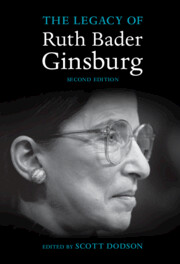Book contents
- The Legacy of Ruth Bader Ginsburg
- The Legacy of Ruth Bader Ginsburg
- Copyright page
- Contents
- Contributors
- Preface
- Foreword
- Acknowledgments
- Introduction to the Second Edition
- Part I Shaping a Legacy
- Part II Rights and Remedies
- Part III Structuralism
- Part IV The Jurist
- 13 Reflections on the Confirmation Journey of Ruth Bader Ginsburg, Summer 1993
- 14 Justice Ginsburg
- 15 Oral Argument as a Bridge between the Briefs and the Court’s Opinion
- 16 Fire and Ice
- Coda
- Notes
- Index
14 - Justice Ginsburg
Demosprudence through Dissent
from Part IV - The Jurist
Published online by Cambridge University Press: 03 March 2022
- The Legacy of Ruth Bader Ginsburg
- The Legacy of Ruth Bader Ginsburg
- Copyright page
- Contents
- Contributors
- Preface
- Foreword
- Acknowledgments
- Introduction to the Second Edition
- Part I Shaping a Legacy
- Part II Rights and Remedies
- Part III Structuralism
- Part IV The Jurist
- 13 Reflections on the Confirmation Journey of Ruth Bader Ginsburg, Summer 1993
- 14 Justice Ginsburg
- 15 Oral Argument as a Bridge between the Briefs and the Court’s Opinion
- 16 Fire and Ice
- Coda
- Notes
- Index
Summary
October Term 2006 was an unusual one for the Supreme Court. On seven occasions, more than any other term on record, a justice issued an oral dissent from the bench.New York Times reporter Linda Greenhouse proclaimed that the term would also “be remembered as the time when Justice Ruth Bader Ginsburg found her voice, and used it.” The events of that year would indeed foreshadow Justice Ginsburg’s role as a forceful and passionate dissenter, an objecting voice within a Court that has been viewed as activist and divided.
- Type
- Chapter
- Information
- The Legacy of Ruth Bader Ginsburg , pp. 189 - 198Publisher: Cambridge University PressPrint publication year: 2022

